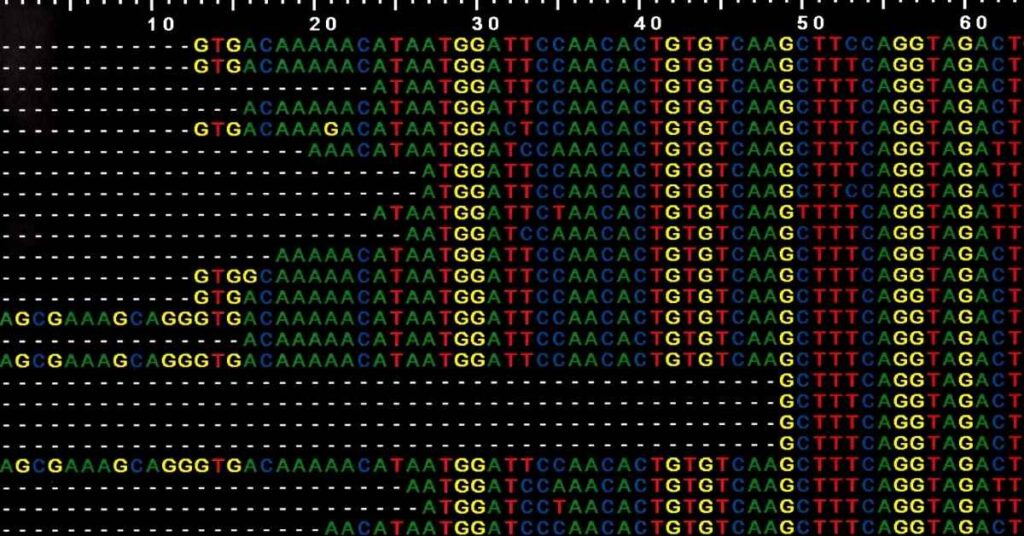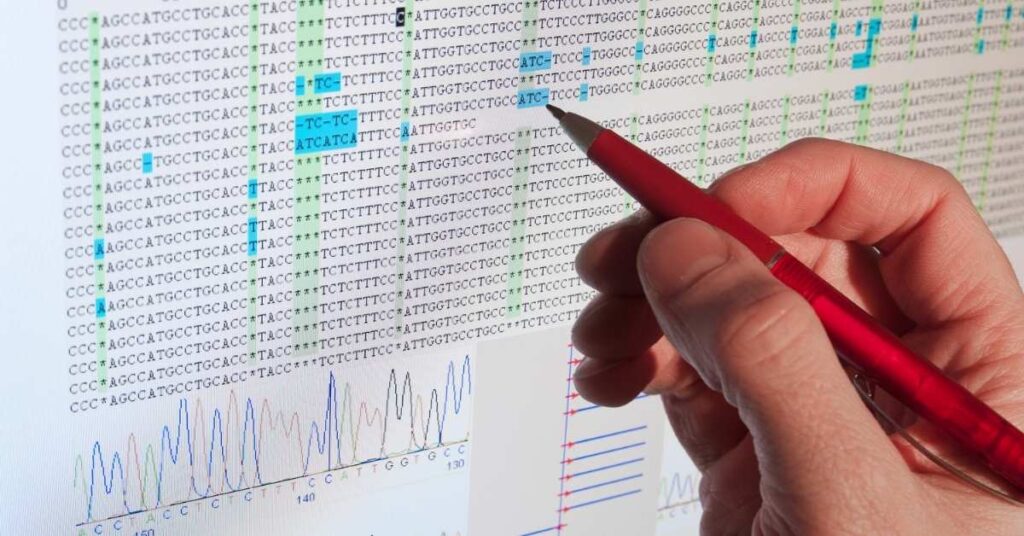Multiple Sequence Alignment In Bioinformatics: In the world of bioinformatics, one of the most intriguing challenges is making sense of the vast amounts of genetic data we’ve uncovered.
How do we compare sequences to identify common patterns? How can we uncover evolutionary relationships or predict the function of unknown genes? The answer lies in a technique called multiple sequence alignment in bioinformatics.
What Is Multiple Sequence Alignment?
At its core, multiple sequence alignment (MSA) involves arranging three or more biological sequences—DNA, RNA, or proteins—to identify regions of similarity. These similarities might indicate functional relationships, structural patterns, or evolutionary connections.
As one researcher aptly put it, “Alignment is the microscope of bioinformatics. Without it, genetic data would remain a cryptic puzzle.”
By aligning sequences, bioinformaticians can infer homology, identify conserved domains, and predict structural motifs crucial in fields like drug discovery and personalized medicine.

Why Is Multiple Sequence Alignment Important?
The significance of MSA lies in its ability to provide insights into fundamental biological questions. Here’s why it’s a game-changer:
- Evolutionary Clues: MSA helps map out how genes and proteins have evolved across different species. Conserved regions often point to essential functions.
- Functional Insights: Unknown sequences can be studied by comparing them to well-characterized ones.
- Structural Prediction: Conserved sequence motifs often correspond to critical structural elements in proteins, aiding in drug design.
- Diagnostics: Clinical tools like BLAST rely on MSA to identify pathogens and recommend treatments.
Whether you’re in academia, healthcare, or industry, MSA forms the backbone of modern biological research.
Methods of Multiple Sequence Alignment
The accuracy of MSA relies heavily on the method employed. There are several approaches, each with its strengths and weaknesses:
- Progressive Alignment
This is the most commonly used method in tools like Clustal Omega. It starts by aligning the most similar sequences and gradually adds others based on similarity. While efficient, it’s sensitive to errors in the early steps.
- Iterative Alignment
Here, sequences are realigned multiple times to refine the results. Tools like MUSCLE (Multiple Sequence Comparison by Log-Expectation) use this method to improve accuracy while maintaining computational efficiency.
- Exact Algorithms
Dynamic programming techniques, such as the Needleman-Wunsch or Smith-Waterman algorithms, are used here. While highly accurate, they are computationally intensive and better suited for smaller datasets.
- Heuristic Methods
These methods trade accuracy for speed, making them ideal for aligning large datasets. Tools like FASTA employ heuristic algorithms.
- Consistency-Based Methods
By incorporating pairwise alignments into the MSA process, this method increases reliability. T-Coffee (Tree-based Consistency Objective Function for alignment Evaluation) is a popular example.
Popular Multiple Sequence Alignment Tools
The right tool can make all the difference in analyzing biological data. Some widely-used multiple sequence alignment tools include the following:
- Clustal Omega: Known for its speed and scalability, ideal for large datasets.
- MUSCLE: Balances accuracy and efficiency, popular for protein alignments.
- T-Coffee: Offers consistency-based alignments, ideal for challenging datasets.
- MAFFT: Highly efficient for large-scale alignments, suitable for genomic data.
- BLAST: Primarily for local alignments but foundational in bioinformatics.
Choose your tool based on your dataset size and research objectives. For instance, Clustal Omega works well for large-scale projects, while T-Coffee excels in precision-critical tasks.

Application of Multiple Sequence Alignment
The application of multiple sequence alignment spans diverse fields. From academia to industry, its utility is undeniable. Here’s where it makes a significant impact:
- Drug Discovery and Development: By identifying conserved protein motifs, MSA aids in designing drugs that target specific enzymes or receptors.
- Disease Diagnostics: In clinical settings, MSA is used to compare pathogen genomes, enabling faster and more accurate diagnostics.
- Evolutionary Biology: It deciphers evolutionary relationships by tracing gene families and species divergence.
- Structural Biology: MSA predicts protein structures by aligning homologous sequences, critical for vaccine development.
- Education and Training: Organizations like LLRI integrate MSA into their bioinformatics and medical coding courses, preparing students for careers in genomics and data science.
Challenges in Multiple Sequence Alignment
While MSA is powerful, it isn’t without its challenges:
- Large Datasets: Handling large volumes of genetic data requires advanced computational resources.
- Balancing Accuracy and Speed: Faster methods may compromise on alignment quality, especially for complex datasets.
- Dynamic Data: With new sequences being discovered daily, keeping alignments updated can be a daunting task.
Despite these hurdles, advancements in algorithms and cloud-based tools are making MSA more accessible and efficient.
On A Final Note…
Multiple sequence alignment in bioinformatics is a cornerstone of modern biological research, bridging the gap between raw data and meaningful insights. Whether it’s predicting protein functions, unraveling evolutionary mysteries, or advancing drug development, its applications are far-reaching.
For those eager to delve into this fascinating field, institutions like LLRI offer cutting-edge courses in bioinformatics, clinical research, and medical coding. The future of biology is data-driven—are you ready to align with it?
-
What is multiple sequence alignment?
It’s a bioinformatics technique used to align three or more sequences to identify similarities, predict functions, and study evolutionary relationships.
-
Which are the best multiple sequence alignment tools?
Popular tools include Clustal Omega, MUSCLE, T-Coffee, and MAFFT, each suited to specific datasets and goals.
-
How is MSA used in drug discovery?
By analyzing conserved regions in protein sequences, MSA helps design targeted drugs with minimal side effects.
-
Can MSA predict protein structures?
Yes, it identifies conserved motifs, which are often key to predicting three-dimensional structures.
-
What are the challenges in MSA?
Scalability, balancing accuracy with speed, and adapting to dynamic datasets are common challenges.
-
Why is MSA critical in education?
It’s foundational to bioinformatics, making it a must-learn skill for careers in genomics, diagnostics, and data-driven biology.

